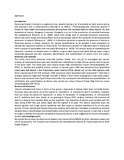Kariuki, SM., Kim, DJ., Dossaji, SF., Kabaru, JM(2011). Molecular species identification and the respective quantification of dioscin: a case of dioscorea spp

View/
Date
2011Author
Kariuki, SM
Kim, DJ
Dossaji, SF
Kabaru, JM
Language
enMetadata
Show full item recordAbstract
Introduction
Dioscorea (Yams) in Kenya is a neglected crop, despite having a lot of potential as food source and as well playing a role in pharmaceutics (Mwirigi et al, 2009 ) . Pharmacologically, Dioscorea species is known to have health promoting molecules among them the steroidal Saponin called dioscin. On acid hydrolysis of dioscin, diosgenin is derived. Diosgenin is us ed in the production of steroidal hormones like progesterone (Sautour et al., 2004). Apart from being used in steroidal hormones production, dioscin has other health promoting effects such as antioxidant effects and reduction of postmenopausal symptoms in women (Wang et al ., 2002). It is therefore essential to quantify the amounts of dioscin in Dioscorea species in Kenya. However, for dioscin quantification to be possible it was imperative to identify the taxonomic position of these yams. The taxonomic position of cultivated yams in Kenya has been a subject of speculation over the years (Mwirigi et al , 2010). This project aimed at establishing the taxonomi c position of Kenyan yams in relation to gene bank species and West African yams using a molecular approach and the respective identification and quantification of dioscin from the tubers. Materials and methods
This study used three universal molecular markers (matK, rbcL, trnL_F) to investigate the species position of cultivated Kenyan yams and identify their relatedness to major African species and to species in the gene bank. The study also used reverse phase High performance Liquid Chromatography (RP-HPLC) to identify and quantify dioscin content in Kenyan yams. DNA was extracted from lyophilized tubers and leaf sample s and Polymerase chain reaction (PCR) carried out on the DNA samples with direct sequencing of the PCR products. DNA sequences were assembled with sequencher ® and then a multiple sequence alignment through clustalW in MEGA 5 from which phylogenetic trees were drawn. Dioscin was extracted from 5g of freeze dried tubers for consequent identification and quantification. Id entification and quantification of dioscin was carried out using a Reverse Phase High Pressure Liquid Chromatography (RP-HPLC).
Results and discussion
Results indicated that there is more to the specie s taxonomy in Kenyan Yams than currently known. Currently yams are said to be of the species D. minutiflora , D. dumetorum and D. bulbifera ; however from our study, the species D. cayanensis , D. alata , D. rotundata , D. mangenotitana , D. schimperiana and D. bulbifera were also shown to be growing in Kenya. HPLC analysis indicated the presence of dioscin in Kenyan yam samples albeit at low quantities. The quantities of dioscin were variable with the least being 0.884 Parts per billion (ppb) and the highest 5.12 ppb). The dioscin quantities were not species specific and a high dioscin variability was also noted in samples identified to be of the same species. Further sampling of Kenyan Dioscorea samples both wild and cultivated is essential to enhance detailed dioscin identification and quantification and as well check for more species. A tool that is robust en ough to identify intra specific variability in Dioscorea species is also suggested for future comparative studies. Acknowledgements
We would like to thank the Biosciences Eastern and Central Africa (BECA) for their Laboratory space and use of equipments. This research was funded by the International Institute of Tropical Agriculture (IITA) Ibadan Nigeria
Citation
.The Molecular species identification and the respective quantification of dioscin: a case of dioscorea spp .14th NAPRECA symposium and AAMPS ethnoveterinary medicine symposium nairobi, 2011Publisher
University of Nairobi
